Alaska Economic Trends
Alaska Economic Trends is a monthly magazine that covers a range of economic topics.
Sign up for a free electronic subscription. 
Sign up for a paid print subscription.
Alaska Economic Trends are searchable from 1961 to the present using the Trends search page. The search can include any combination of the following: Key Words, Date Range, Author, Category

Alaska's economy faces significant headwinds in 2016, largely due to sustained low oil prices. The state is forecast to lose about 2,500 jobs in 2016, a 0.7 percent decline, after gaining 1,700 jobs in 2015. This would be the first year of job losses since 2009, when Alaska felt the wake from the national recession. The state's job growth rebounded quickly in 2010 and remained relatively strong through 2012, buoyed by the federal stimulus package, large capital budgets, and high oil prices. Growth slowed to a crawl in 2013, and employers added jobs at a yearly rate of half a percentage point or less between 2013 and 2015.
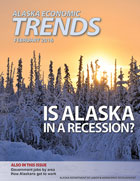
Talk of Alaska being in a recession - or heading for one - has grown over the last year as oil prices have plunged. But what exactly is a recession, and what does it mean if we're in one? For states, there's no accepted definition on of a recession, and coming up with one isn't clear-cut. Nationally, the National Bureau of Economic Research - a private, nonprofit research group - and its Business Cycle Dating Committee are the recognized authority on identifying when the country entered a recession and when it ended. For example, the most recent national recession, often called the 'Great Recession'.

Registered apprenticeships have become an increasingly popular option for Alaskans who want to advance their education, especially after high school. Nearly 9,000 people participated in a registered apprenticeship program between 2004 and 2014, and new registrations were over 50 percent higher in 2014 than in 2004. A registered apprenticeship, recognized by the U.S. Department of Labor, usually consists of at least 2,000 hours of paid on-the-job training plus classroom technical instruction. As apprentices gain experience, their wages increase.

Alaska's mix of industries has grown to look a bit more like the rest of the nation over time, but we're still a long ways off. It's also unlikely we'll ever mimic the national economy. In no other state do oil, tourism, fishing, and the federal government play such fundamental roles. And given the small size of our economy, its seasonality, our expansive geography, and our largely public land ownership and natural resource endowment, Alaskans will likely continue to hold a unique mix of jobs.
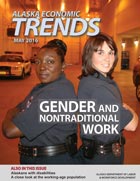
Alaska has long been considered a land of economic opportunity for rugged people willing to take on risk and harsh conditions. Historically, men took advantage of those opportunities far more frequently than women, largely due to social, legal, and economic barriers to women participating in nontraditional work. Despite those limitations, many women made their mark on Alaska's history as prospectors, bush pilots, politicians, and in nearly every other profession in the last frontier.

At 10 percent, Alaska has a higher share of veterans than any other state. Four other states come close at 9 percent and nationwide it's 7 percent. Alaska's high percentage of veterans, defined here as civilians who were previously active duty in any branch of the military including the Coast Guard, is tied to our military history. During World War II, the U.S. established major military bases near Anchorage and Fairbanks and built a number of other facilities, such as a Naval Air Station on Kodiak Island. Military presence peaked in 1943, when more than 150,000 personnel represented over 60 percent of the state's population.

The biggest news for our living costs over the past year has been the continuing decline in energy prices. In Anchorage, which is the only place in the state where inflation is measured, energy prices fell by 10.3 percent in 2015, the single largest annual decline since 2009. Gasoline prices alone fell nearly 25 percent. Lower energy prices are heavily tied to other categories, particularly transportation, which fell by nearly 7 percent. Because transportation has such a large 'weight' in the index - which means it's a significant expenditure for most households - these changes have a powerful effect on the overall inflation rate.

Our 2016 annual residential rental survey shows that Alaska rents are essentially level with last year and the overall rental vacancy rate has fallen slightly. Statewide, rents have increased just seven-tenths of a percentage point, or $9, since last year, bringing the average rent for all unit types to $1,238 including utilities.
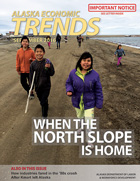
Hundreds of millions of years ago, shale, sandstone, and other organic matter was deposited on the northern coast of Alaska, washing in with the tides or sliding off the mountain ranges. These substances lay dormant, compressing into oil over time. It was the discovery of this massive oil deposit at Prudhoe Bay in 1968 that brought the North Slope's people and geology to the world stage and changed the course of Alaska's future, ushering in the construction of the Trans-Alaska Oil Pipeline and bringing in a flood of outside workers and interests.

The oil price drop that began two years ago has dampened Alaska's economic outlook, but the state is still projected to add 19,652 jobs between 2014 and 2024, equating to 5.8 percent growth. While we expect most industries to grow over the 10-year period, several that are linked to oil and gas are projected to lose ground.
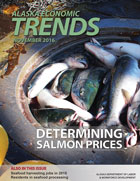
Commercial salmon harvesting is vital to many coastal towns and employs far more people than any other Alaska fishery. The salmon fishing industry is highly volatile, with prices and catch volumes subject to big changes from year to year. From 2013 to 2015, for example, prices for Alaska pink and sockeye salmon fell by over 50 percent.
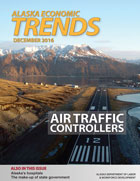
Air traffic controllers play an outsized role in a state that relies heavily on air transportation and where pilots face a wide range of hazards. Alaska has more air traffic controllers per capita than any other state - seven times the national average and nearly twice that of the next-highest state, New Hampshire. Alaska has about 500 civilian air traffic controllers - 2.2 percent of the U.S. total - and nearly all of them work for the Federal Aviation Administration or as federal contractors. An additional 117 controllers are military.
